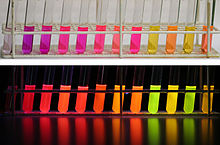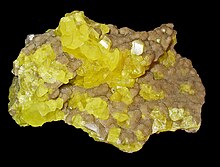A chemical substance is a form of matter that has constant chemical composition and characteristic properties.[1] It cannot be separated into components by physical separation methods, i.e., without breaking chemical bonds. Chemical substances can be chemical elements,chemical compounds, ions or alloys.
Chemical substances are often called 'pure' to set them apart from mixtures. A common example of a chemical substance is pure water; it has the same properties and the same ratio of hydrogen to oxygen whether it is isolated from a river or made in a laboratory. Other chemical substances commonly encountered in pure form are diamond (carbon), gold, table salt (sodium chloride) and refined sugar(sucrose). However, in practice, no substance is entirely pure, and chemical purity is specified according to the intended use of the chemical.
Chemical substances exist as solids, liquids, gases or plasma, and may change between these phases of matter with changes intemperature or pressure. Chemical reactions convert one chemical substance into another.
Forms of energy, such as light and heat, are not considered to be matter, and thus they are not "substances" in this regard.
Definition
A chemical substance (also called a pure substance) may well be defined as "any material with a definite chemical composition" in an introductory general chemistry textbook.[2] According to this definition a chemical substance can either be a pure chemical element or a pure chemical compound. But, there are exceptions to this definition; a pure substance can also be defined as a form of matter that has both definite composition and distinct properties.[3] The chemical substance index published by CAS also includes several alloys of uncertain composition.[4] Non-stoichiometric compounds are a special case (in inorganic chemistry) that violates the law of constant composition, and for them, it is sometimes difficult to draw the line between a mixture and a compound, as in the case of palladium hydride. Broader definitions of chemicals or chemical substances can be found, for example: "the term 'chemical substance' means any organic or inorganic substance of a particular molecular identity, including – (i) any combination of such substances occurring in whole or in part as a result of a chemical reaction or occurring in nature"[5]
In geology, substances of uniform composition are called minerals, while physical mixtures (aggregates) of several minerals (different substances) are defined as rocks. Many minerals, however, mutually dissolve into solid solutions, such that a single rock is a uniform substance despite being a mixture in stoichiometric terms. Feldspars are a common example: anorthoclase is an alkali aluminium silicate, where the alkali metal is interchangeably either sodium or potassium.
In law, "chemical substances" may include both pure substances and mixtures with a defined composition or manufacturing process. For example, the EU regulation REACHdefines "monoconstituent substances", "multiconstituent substances" and "substances of unknown or variable composition". The latter two consist of multiple chemical substances; however, their identity can be established either by direct chemical analysis or reference to a single manufacturing process. For example, charcoal is an extremely complex, partially polymeric mixture that can be defined by its manufacturing process. Therefore, although the exact chemical identity is unknown, identification can be made to a sufficient accuracy. The CAS index also includes mixtures.
Polymers almost always appear as mixtures of molecules of multiple molar masses, each of which could be considered a separate chemical substance. However, the polymer may be defined by a known precursor or reaction(s) and the molar mass distribution. For example, polyethylene is a mixture of very long chains of -CH2- repeating units, and is generally sold in several molar mass distributions, LDPE, MDPE, HDPE and UHMWPE.
Chemical elements
An element is a chemical substance that is made up of a particular kind of atoms and hence cannot be broken down or transformed by a chemical reaction into a different element, though it can be transmutated into another element through a nuclear reaction. This is so, because all of the atoms in a sample of an element have the same number of protons, though they may be different isotopes, with differing numbers of neutrons.
As of 2012, there are 118 known elements, about 80 of which are stable – that is, they do not change by radioactive decay into other elements. Some elements can occur as more than a single chemical substance (allotropes). For instance, oxygen exists as both diatomic oxygen (O2) and ozone (O3). The majority of elements are classified as metals. These are elements with a characteristic lustre such asiron, copper, and gold. Metals typically conduct electricity and heat well, and they are malleable and ductile.[8] Around a dozen elements,[9]such as carbon, nitrogen, and oxygen, are classified as non-metals. Non-metals lack the metallic properties described above, they also have a high electronegativity and a tendency to form negative ions. Certain elements such as silicon sometimes resemble metals and sometimes resemble non-metals, and are known as metalloids.
Chemical compounds
A pure chemical compound is a chemical substance that is composed of a particular set of molecules or ions. Two or more elements combined into one substance through a chemical reaction form a chemical compound. All compounds are substances, but not all substances are compounds.
A chemical compound can be either atoms bonded together in molecules or crystals in which atoms, molecules or ions form a crystalline lattice. Compounds based primarily on carbon and hydrogen atoms are called organic compounds, and all others are called inorganic compounds. Compounds containing bonds between carbon and a metal are called organometallic compounds.
Compounds in which components share electrons are known as covalent compounds. Compounds consisting of oppositely charged ionsare known as ionic compounds, or salts.
In organic chemistry, there can be more than one chemical compound with the same composition and molecular weight. Generally, these are called isomers. Isomers usually have substantially different chemical properties, may be isolated and do not spontaneously convert to each other. A common example is glucose vs. fructose. The former is an aldehyde, the latter is a ketone. Their interconversion requires either enzymatic or acid-base catalysis. However, there are also tautomers, where isomerization occurs spontaneously, such that a pure substance cannot be isolated into its tautomers. A common example is glucose, which has open-chain and ring forms. One cannot manufacture pure open-chain glucose because glucose spontaneously cyclizes to the hemiacetal form. Materials may also comprise other entities such as polymers. These may be inorganic or organic and sometimes a combination of inorganic and organic.
Naming and indexing
Every chemical substance has one or more systematic names, usually named according to the IUPAC rules for naming. An alternative system is used by the Chemical Abstracts Service (CAS).
Many compounds are also known by their more common, simpler names, many of which predate the systematic name. For example, the long-known sugar glucose is now systematically named 6-(hydroxymethyl)oxane-2,3,4,5-tetrol. Natural products and pharmaceuticals are also given simpler names, for example the mild pain-killer Naproxen is the more common name for the chemical compound (S)-6-methoxy-α-methyl-2-naphthaleneacetic acid.
Chemists frequently refer to chemical compounds using chemical formulae or molecular structure of the compound. There has been a phenomenal growth in the number of chemical compounds being synthesized (or isolated), and then reported in the scientific literature by professional chemists around the world.[13] An enormous number of chemical compounds are possible through the chemical combination of the known chemical elements. As of May 2011, about sixty million chemical compounds are known.[14] The names of many of these compounds are often nontrivial and hence not very easy to remember or cite accurately. Also it is difficult to keep the track of them in the literature. Several international organizations like IUPAC and CAS have initiated steps to make such tasks easier. CAS provides the abstracting services of the chemical literature, and provides a numerical identifier, known as CAS registry number to each chemical substance that has been reported in the chemical literature (such as chemistry journals and patents). This information is compiled as a database and is popularly known as the Chemical substances index. Other computer-friendly systems that have been developed for substance information, are: SMILES and the International Chemical Identifier or InChI.



No comments:
Post a Comment